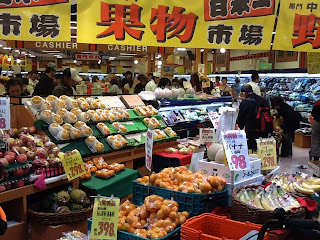MY RECENT TRIP TO KANSAI DISTRICT, JAPAN – PART 2: FOOD,
LIFESTYLES, CULTURAL TRAITS.
This is the sequel to my earlier sharing posted about a week
ago. Again, I am trying to avoid verbiage but instead let my pictures do most
of the talk and walk around with captions. However, to complement the entire
overview regarding my experience on food, lifestyles and culture during my
eight-day visit there, allow me to sum up a few key observations first:
· *In a nutshell, the people were courteous, well-mannered,
agile, orderly and tidy. They moved fast.
·
*Everywhere was the environment of hygiene and
cleanliness. I hardly saw any speck of litter in the streets and public places.
Even the public toilets were very clean.
·
*The people were generally smartly dressed. The
common office attire for men included dark suit and tie. Even employees manning
ticketing counters looked smart in suit or blazer.
·
*It’s not their culture to accept tips. In one
instance, one of us left some tips in the tray after settling the bill in a
restaurant; and after we had walked out to some distance away, the cashier came
running to return the money. At a busy supermarket, another friend missed
picking up 1 yen change from the tray after making payment; likewise a worker ran
to us to return the coin.
·
*Easy vehicle traffic. We did not witness any
traffic jam even in the large cities of Osaka, Kobe and Kyoto. Most Japanese
used trains to commute. My group did not hire taxis since the train and subway networks
were encompassing enough to cover where we wanted to go. For shorter travel
time, we chose rapid trains which charged higher rates. We also took the normal
trains, which had more route stops. when we did not need to rush from one place
to the next. Yes, the trains were very punctual in accordance to specific
timing. Cycling was also a common mode of commutation. I saw many smartly
dressed Japanese cycling in the hearts of Osaka, Kobe and Kyoto.
·
*Reading seemed to be a common habit. I witnessed
many commuters reading books in trains rather than whiling away time.
·
*Popular hang-out spots for men in the evening (I
presume after work because they were in suit and tie) were the small local restaurants
and bars. Many such outlets had karaoke facilities. The smallest outlets did
not have stools – patrons stood around bar counters to drink and eat. Drinking
culture” was prevalently seen.
·
*Ladies in kimono were not commonly seen unless
in shrines, temples or some special events, or in entertainment outlets.
·
*Osaka appeared to be a “shopping city” hoarded
with lots of ladies’ stuffs and branded goods. However, prices were not cheap
compared to many other Asian countries. Unlike Malaysia, the malls there hardly
had public benches for shoppers to rest.
·
*I noticed that Japanese women, especially younger
ladies, liked to wear heavy makeup.
· *Cost of food was also not cheap too compared to
other Asian countries. A small set of noodle or rice meal ranged from 650 to
1,000 Yen on the average (1,000 Yen was equivalent to 40 Malaysian Ringgit).
(Prime beef BBQ dinner in the first evening upon our arrival. Succulent and "juicy". No, it's not Kobe Beef (the most pricy beef which would cost more than RM500 equivalent per piece of steak). This meal cost us about RM100 per head.)
(A small supermarket in a market street - well stocked with foodstuffs and nicely displayed.)
(Japanese puffer fish - a famous delicacy. If sliced the wrong way, the meat would be lethally poisonous. The vendors would slice the fish meat for customers.We were tempted to try but dared not venture to take the risk. Note the exorbitant prices.....as high as 16,000 Yen - equivalent to RM640 - in an ordinary market street.)
(To be eaten raw.......at the seafood market in Wakayama)
(Fresh and processed seafood in the Osaka wholesale market.)
(Varieties for taste buds in another food street........fresh chestnuts for frying on the spot, smoked fish, processed "bites" and tit-bits.)
(Kirin Beer, one of the popular beer brands in Japan. It also comes in the "alcohol free" version.......tasted like normal beer to me but without the "arousing" sensation.)
(Freshly brewed Japanese green tea, rich green in colour..........available in Orima-Onsen.)
(Shabu-shabu, steamboat dinner Japanese style........about 3,000 Yen per head. I would grade this meal 6 or 7 points from a scoreboard of 1-10. Suited quite well for the slightly cold weather when we savoured it.)
(We took this from a MOS Burger outlet. This was the best burger I had ever tasted. Cost equivalent to RM12.- RM13.)
(See how well and smartly dressed were these employees in red.)
(Students in smart uniforms, participating outdoor activities.)
(No longer a very common sight.......ladies in kimono and traditional footwear. These pictures were captured nearby a temple area. The young ones were petite, cute and graceful......the older ones were yet resplendent.)
(If I were a lady - which I'm not - I would have bought one set for my wardrobe.....not cheap.)
(Pretty decorative items for display in home and as souvenirs.......again, quite pricy.)
(A small but cute looking house.......plenty of such found at the peripheral areas of cities. Land space and accommodation properties are definitely very costly.)
(We took the rapid train to Osaka city upon arrival at Osaka Airport. Very clean and comfortable.)
(A normal train to the suburbs........also very clean.)
(Moving about on bicycles.........also another common mode of commutation.)
(A bicycle parking area.)
(Clean streets, free of litter. Cleanliness is a prominent cultural trait in Japan.)
(The Japanese education system believes in a balance between academic, physical, social and cultural elements........both indoor and outdoor.)
(University students on the way to do social work.....cleaning the compound of the Osaka Castle area.)
(Firming up young female students.........physically and mentally.)
(Studying culture and doing homework in a temple compound on a Saturday.)
That's all folks!






































0 comments:
Post a Comment